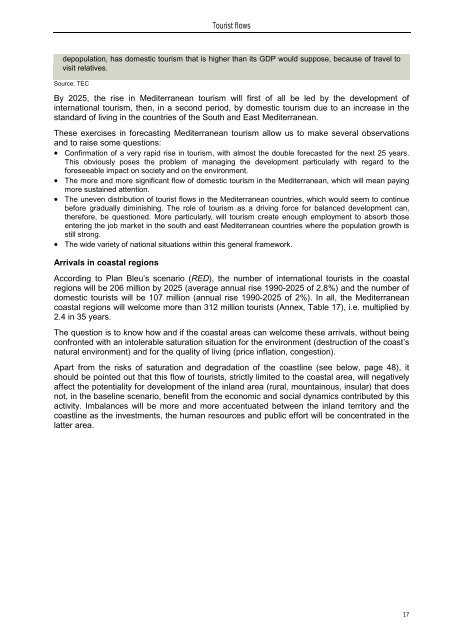dossier sur le tourisme et le développement durable
dossier sur le tourisme et le développement durable
dossier sur le tourisme et le développement durable
Create successful ePaper yourself
Turn your PDF publications into a flip-book with our unique Google optimized e-Paper software.
Tourist flows<br />
depopulation, has domestic tourism that is higher than its GDP would suppose, because of travel to<br />
visit relatives.<br />
Source: TEC<br />
By 2025, the rise in Mediterranean tourism will first of all be <strong>le</strong>d by the development of<br />
international tourism, then, in a second period, by domestic tourism due to an increase in the<br />
standard of living in the countries of the South and East Mediterranean.<br />
These exercises in forecasting Mediterranean tourism allow us to make several observations<br />
and to raise some questions:<br />
• Confirmation of a very rapid rise in tourism, with almost the doub<strong>le</strong> forecasted for the next 25 years.<br />
This obviously poses the prob<strong>le</strong>m of managing the development particularly with regard to the<br />
foreseeab<strong>le</strong> impact on soci<strong>et</strong>y and on the environment.<br />
• The more and more significant flow of domestic tourism in the Mediterranean, which will mean paying<br />
more sustained attention.<br />
• The uneven distribution of tourist flows in the Mediterranean countries, which would seem to continue<br />
before gradually diminishing. The ro<strong>le</strong> of tourism as a driving force for balanced development can,<br />
therefore, be questioned. More particularly, will tourism create enough employment to absorb those<br />
entering the job mark<strong>et</strong> in the south and east Mediterranean countries where the population growth is<br />
still strong.<br />
• The wide vari<strong>et</strong>y of national situations within this general framework.<br />
Arrivals in coastal regions<br />
According to Plan B<strong>le</strong>u’s scenario (RED), the number of international tourists in the coastal<br />
regions will be 206 million by 2025 (average annual rise 1990-2025 of 2.8%) and the number of<br />
domestic tourists will be 107 million (annual rise 1990-2025 of 2%). In all, the Mediterranean<br />
coastal regions will welcome more than 312 million tourists (Annex, Tab<strong>le</strong> 17), i.e. multiplied by<br />
2.4 in 35 years.<br />
The question is to know how and if the coastal areas can welcome these arrivals, without being<br />
confronted with an into<strong>le</strong>rab<strong>le</strong> saturation situation for the environment (destruction of the coast’s<br />
natural environment) and for the quality of living (price inflation, congestion).<br />
Apart from the risks of saturation and degradation of the coastline (see below, page 48), it<br />
should be pointed out that this flow of tourists, strictly limited to the coastal area, will negatively<br />
affect the potentiality for development of the inland area (rural, mountainous, insular) that does<br />
not, in the baseline scenario, benefit from the economic and social dynamics contributed by this<br />
activity. Imbalances will be more and more accentuated b<strong>et</strong>ween the inland territory and the<br />
coastline as the investments, the human resources and public effort will be concentrated in the<br />
latter area.<br />
17
















